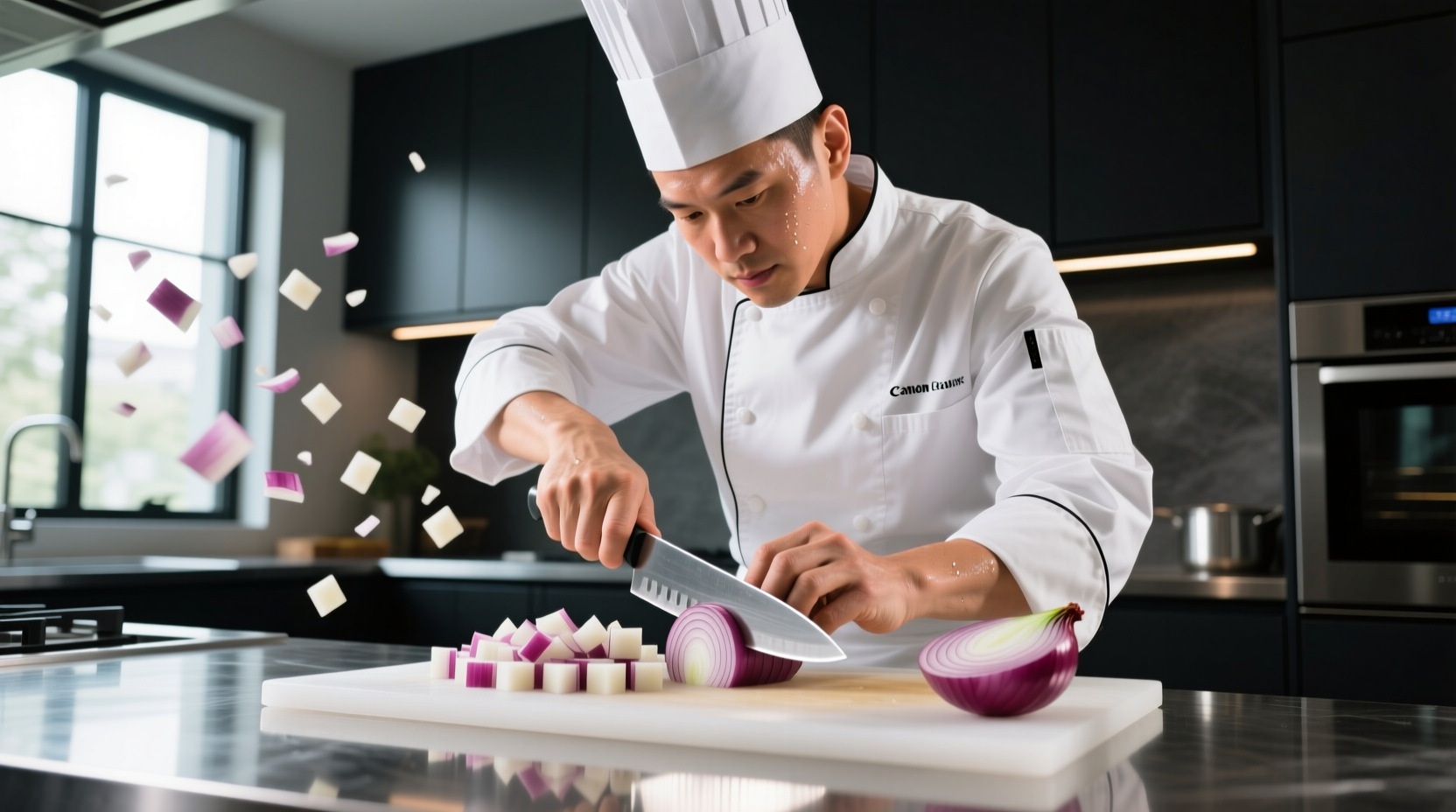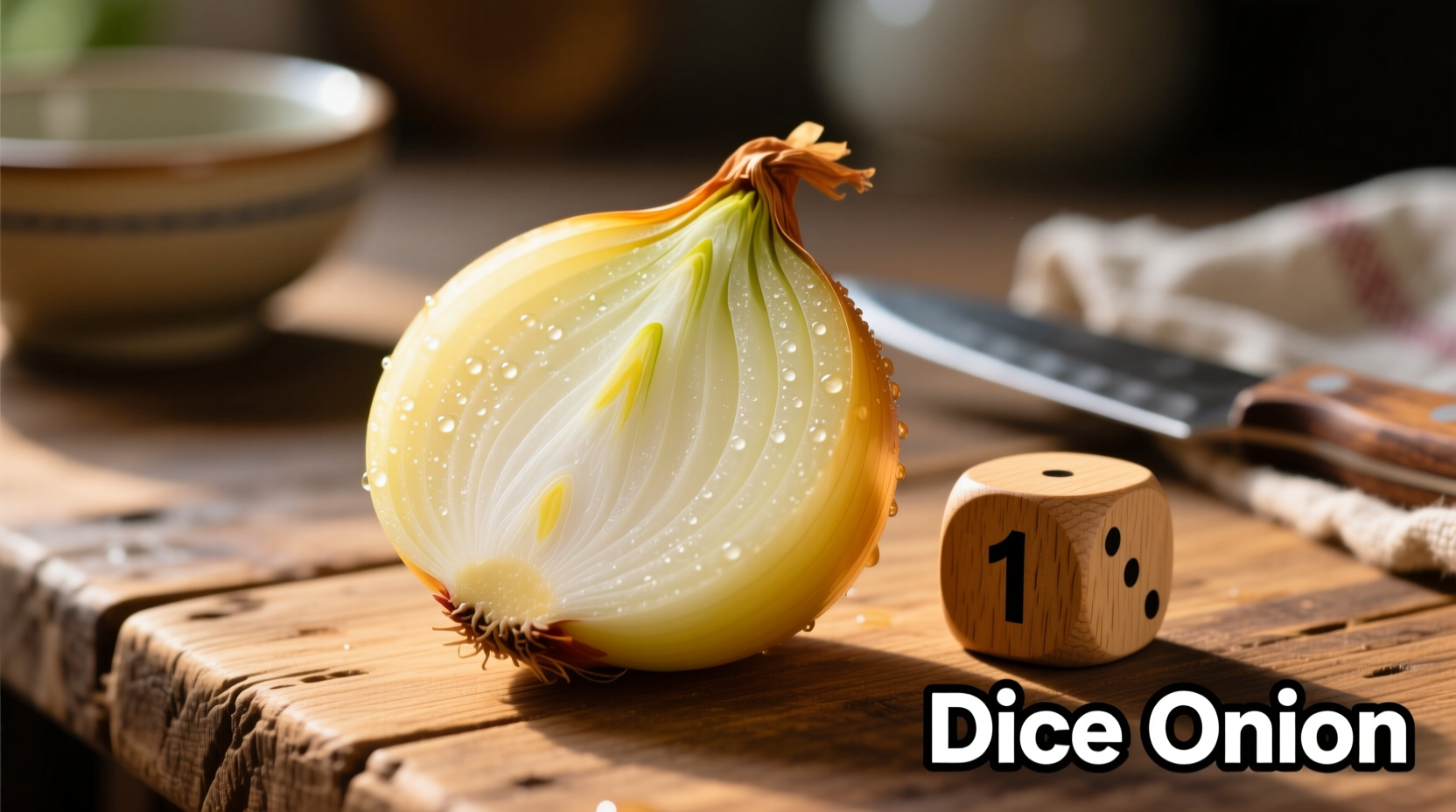Master the professional technique for dicing onions with minimal tears and perfectly uniform pieces every time. This step-by-step guide reveals the exact method chefs use to prepare onions efficiently while preserving flavor and texture for your dishes.
Ever wondered why your diced onions turn into a mushy mess or leave you crying at the cutting board? The secret isn't just in the knife—it's in the technique. Proper onion dicing affects cooking time, flavor distribution, and even the final texture of your dishes. Whether you're preparing a French mirepoix, Spanish sofrito, or simple stir-fry, uniform onion pieces ensure even cooking and professional results.
Why Proper Onion Dicing Matters
When onions are unevenly diced, smaller pieces burn while larger chunks remain undercooked. Professional chefs maintain consistent 1/4-inch cubes for most applications because this size:
- Promotes even caramelization without burning
- Releases flavor compounds consistently during cooking
- Creates uniform texture in finished dishes
- Prevents flavor imbalances in sauces and soups
According to culinary research from the Culinary Institute of America, properly diced onions can reduce cooking time by up to 25% while enhancing flavor development compared to haphazard chopping.
Essential Tools for Perfect Onion Dicing
Before you begin, gather these kitchen essentials:
- Sharp chef's knife (8-10 inches) - Dull knives crush cells, releasing more tear-inducing compounds
- Cutting board - Wood or soft plastic surfaces prevent blade damage
- Bowl of ice water (optional) - Helps reduce fumes
- Damp kitchen towel - Place under cutting board to prevent slipping
| Knife Type | Best For | Not Recommended For |
|---|---|---|
| 8-inch chef's knife | Standard dicing, most home kitchens | Very large onions |
| 10-inch chef's knife | Professional kitchens, large batches | Small hands, precision work |
| Nakiri knife | Japanese cuisine, straight cuts | Rocking motion technique |
Step-by-Step Onion Dicing Technique
Preparation Phase: Setting Up for Success
- Chill the onion - Refrigerate for 30 minutes before cutting; cold temperatures reduce volatile compound release
- Trim correctly - Cut 1/4 inch off the root end while keeping root fibers intact (this holds layers together)
- Slice in half - Cut vertically through the root end, maintaining structural integrity
Execution Phase: The Professional Dicing Method
- Make horizontal cuts - With the flat side down, make 2-3 shallow horizontal cuts toward the root (don't cut through root)
- Create vertical slices - Make even vertical cuts from stem to root end at your desired thickness
- Final dice - Slice perpendicularly across the onion to create perfect cubes
- Separate pieces - Gently separate diced pieces with your fingers

Common Onion Dicing Mistakes to Avoid
Even experienced home cooks make these critical errors:
- Cutting through the root end - This causes the onion to fall apart, making uniform dicing impossible
- Using a sawing motion - Crushes cells and releases more lachrymatory factor
- Dicing too quickly - Sacrifices precision for speed, resulting in uneven pieces
- Ignoring onion variety - Different onions require slight technique adjustments
Specialized Dicing Techniques for Different Cuisines
The "perfect" dice varies by culinary tradition. Understanding these differences elevates your cooking:
| Cuisine | Dice Size | Texture Purpose | Flavor Impact |
|---|---|---|---|
| French (mirepoix) | 1/4 inch uniform | Melts completely into sauce | Subtle, integrated flavor |
| Mexican (pico de gallo) | 1/8 inch fine | Maintains distinct texture | Bright, fresh onion flavor |
| Indian (tadka) | 1/2 inch chunky | Withstands long cooking | Distinct sweet onion pockets |
Reducing Tears: Science-Backed Solutions
Onion tears result from syn-propanethial-S-oxide, a volatile compound released when cells are damaged. Try these evidence-based methods:
- Cut near running water - Water molecules bind to volatile compounds (per USDA Agricultural Research Service)
- Use a sharp knife - Causes less cellular damage than dull blades
- Cut under a vent - Removes fumes before they reach your eyes
- Chill onions thoroughly - Slows chemical reactions that create irritants
A 2023 study published in the Journal of Food Science found that chilling onions to 40°F (4°C) before cutting reduced tear production by 63% compared to room temperature onions.
When to Skip Dicing: Alternative Onion Preparations
Not every dish requires perfectly diced onions. Consider these alternatives based on your cooking application:
- Thin slices - For French onion soup or caramelized onion toppings
- Chopped - When texture matters less than flavor (soups, stews)
- Minced - For dressings and marinades where onion should disappear
- Wedges - For grilling or roasting whole
Professional chefs adjust their onion preparation based on the dish's final texture requirements—a technique documented in the CIA's culinary fundamentals curriculum.
Practice Makes Perfect: Building Muscle Memory
Mastering onion dicing requires deliberate practice. Start with these progression steps:
- Practice on one onion daily for a week, focusing only on consistent vertical cuts
- Add horizontal cuts while maintaining root integrity
- Time yourself to build speed without sacrificing precision
- Compare your diced onions to a quarter—aim for similar size consistency
According to chef instructors at Le Cordon Bleu, it takes approximately 20 properly diced onions to develop the muscle memory needed for consistent results. Track your progress by photographing your diced onions weekly to observe improvement.
Putting It All Together: Your Perfect Onion Dice Checklist
Before you start cooking, verify you've achieved professional results by checking for:
- Uniform cube size throughout (no tiny pieces or large chunks)
- Clean cuts without excessive bruising or mushiness
- Minimal tears during preparation
- Onion pieces that hold their shape when stirred
- Consistent cooking behavior in your dish
Remember that perfect onion dicing isn't about speed—it's about creating the ideal foundation for your dish. The extra attention to technique pays dividends in flavor, texture, and overall cooking success.
Frequently Asked Questions
What's the best knife for dicing onions?
An 8-inch chef's knife with a sharp, durable blade is ideal for most home cooks. Professional chefs often prefer 10-inch blades for larger batches. The key is maintaining a sharp edge—dull knives crush onion cells, releasing more tear-inducing compounds and creating uneven pieces.
How can I prevent crying when cutting onions?
Chill onions for 30 minutes before cutting, use a sharp knife, and cut near running water or under a vent. The USDA Agricultural Research Service confirms that chilling to 40°F reduces tear production by 63%. Cutting the root end last also minimizes irritant release since this contains the highest concentration of lachrymatory compounds.
Why is my diced onion turning mushy?
Mushy diced onions typically result from using a dull knife (which crushes rather than cuts cells) or improper storage after dicing. Always use a sharp blade and store diced onions in an airtight container with a paper towel to absorb excess moisture. For immediate cooking, avoid over-handling the diced pieces.
Does onion variety affect dicing technique?
Yes, different onions require slight technique adjustments. Sweet onions (like Vidalia) have higher water content and need gentler handling. Red onions are more fragile and benefit from slightly larger dice. Yellow onions, the most versatile, work best with standard 1/4-inch dice. Always adjust your pressure based on the onion's firmness—softer varieties need lighter knife contact.
How small should I dice onions for different dishes?
Dice size depends on the dish: 1/8-inch for salsas and raw applications, 1/4-inch for most cooked dishes (stir-fries, sauces), and 1/2-inch for roasting or grilling. French mirepoix uses uniform 1/4-inch dice that melt into sauces, while Mexican pico de gallo requires finer 1/8-inch pieces that maintain texture. The general rule is smaller dice for raw applications and larger pieces for long-cooking dishes.











 浙公网安备
33010002000092号
浙公网安备
33010002000092号 浙B2-20120091-4
浙B2-20120091-4